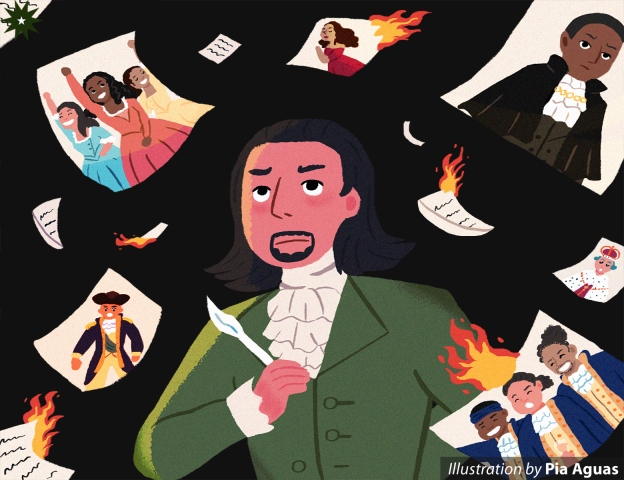Not everyone can be “in the room where it happens”, but now it’s a possibility. Sort of.
Hamilton hardly needs any introduction. The cultural and internet phenomenon based on United States Founding Father Alexander Hamilton’s biography was unavoidable in 2016. Articles praising the show’s music—an inspired blend of rap, hip-hop, R&B, and show tunes—and diverse casting ran rampant across the internet.
Because tickets were notoriously difficult to acquire, in addition to the lack of access to international fans, many got their first taste of Hamilton through the cast album and grainy bootleg videos uploaded on online sites.
After years of eagerly anticipating the “Hamilfilm”, as fans have taken to calling it, a visual recording of the musical was finally made available for fans with access to the streaming service Disney Plus on July 3. Not really a film in the traditional sense—think more The Phantom of the Opera at the Royal Albert Hall than the 2004 movie adaptation—Disney Plus’ Hamilton is a recording of the live production in the Richard Rodgers Theatre on Broadway in June 2016 starring the original Broadway cast and directed by the original musical’s stage director, Thomas Kail.
Theater is meant to be experienced, and now finally, fans can experience Hamilton through their screens.
Wait for it
Disney Plus’ Hamilton was supposed to have a theatrical release in 2021, but because of the COVID-19 pandemic, it was released earlier on Disney’s streaming service. Unfortunately, due to the nature of the platform and keeping with Disney’s reputation, parts of the musical were censored. According to Lin-Manuel Miranda, who wrote the musical and played the titular role, two expletives had to be censored to appease the Motion Picture Association film rating system. Seemingly for other fans, it’s a small price to pay to finally see the original Broadway cast in high resolution.
However, it was not a film shot stationarily from a single angle, like the handheld bootleg recordings fans lived off for years. Kail shot the film from different angles, giving the viewer a more immersive and dynamic visual experience. It not only utilizes close-ups and bird’s eye views of the stage, but it also framed some scenes from backstage.
The set design isn’t very elaborate and there isn’t much in the way of props, which further pushes viewers to focus on the actors’ performances. Such a setup isn’t really new, but what is unique is the turntable at the center of the stage. It allows the stage itself to move with the actors, letting the environment come alive and enhance certain aspects of the story.

Satisfied
The music and performances are equally wonderful. For example, the high-energy performance of My Shot is given an extra boost of energy with viewers not only hearing the ensemble but also seeing them move in sync with each lyric. In You’ll be back and What comes next?, Jonathan Groff’s comedic timing and facial expressions sold King George’s sassy and intense demeanor. There is always an infectious charm whenever Daveed Diggs’ Marquis de Lafayette graces the stage and raps with a French accent. Phillipa Soo grants us a stunning performance as Eliza as well, with Burn being a sucker punch conveying heartbreak, pain, and betrayal.
A particular standout in the musical is Renée Elise Goldsberry. The character of Angelica Schuyler has always been popular with fans and Goldsberry masterfully displays how torn Angelica is between her feelings for Hamilton and love for Eliza—capturing the sentiments of duty and longing that the song tries to balance. A visual treat, the turntable spun with the first “rewind”, symbolizing how we are “rewinding” to an earlier time in the narrative.
Not throwing away their shot
Each actor offers something unique to their character, fleshing them out and imbuing each line with such charm that they only need the barest of lines to make an impact. In fact, the performances are so distinct that the double casting—when the same actor plays multiple characters—is deftly utilized to emphasize similarities between characters and how the choice of casting ties into the narrative.
Having the actor playing both Lafayette and Thomas Jefferson sing, “We fought with him” alludes to how these two characters “fought with” Hamilton in their time with him. The implications of “Me? I loved him” undergoes a metamorphosis with Jasmine Cephas Jones transforming from Peggy to Maria.
The world was wide enough
If fan excitement is any hint, we can see that people greatly prefer official recordings of stage performances instead of a fundamentally misguided film adaptation. Watching the “Hamilfilm” may never be as good as watching the musical live, but it remains a worthwhile experience for loyal fans and newcomers alike. Further, an extensive amount of Hamilton content can be experienced through other sources. The cast album and the Hamilton Mixtape are available on Spotify, and there are a lot of videos of the original Broadway and West End cast.
With COVID-19 bringing more theater productions online, people who might not have had the opportunity to watch them before now have the chance to experience them. Fears that having a readily available recording of a show will draw away fans from watching it live is unfounded. The reception Ang Huling El Bimbo received from its limited online run shows us that people are interested in theater, and increasing accessibility to the arts would only benefit us all.
Live theater creates a relationship between the audience and performers that can’t be replicated by watching through a screen. However, having theater and the arts more accessible gives more people who might not normally be able to experience the show the chance to support and enjoy it in a different way.
Rating: 3.5/4.0
